#liminal spacetime
Text
DP x DC Ancient of Space: Lair
I’ve seen Danny being the ancient of space pop up a few times. A lot of it interprets that as the ancient of outer space, but I propose he has dominion pver the concept of physical space. Clockwork has time, Danny would have space, making them the counterparts for each other
So, imagine if you will, Danny only recently coming into his spatial powers retreating to his lair in the Ghost Zone. It’s too dangerous to have uncontrolled spatial distortions just randomly appearing in the human world.
His lair is an extension of himself. His spatial powers extend not just to himself, but to his lair. It connects to liminal spaces. Walking through school hallways after hours? One of those doors leads to his lair. All night diner with flickering florescent lights and you’re the only customer? Carefull going to the bathroom or you might just end up somewhere else. Closed down building, or even buildings that never were there. Sometimes at just the right time, places just exsist, and they all lead to Danny’s lair. Inside is an MC Escher esque labyrinth of rooms, hallways, tunnels, ever shifting as their connections to the human world alter and shift.
Enter the Batfam
I pick Tim for this. He sees a building he’s never seen before on a street he’s very familiar with. He checks the address.
“Hey Oracle? Is there a 147 Becker street?”
“No, Becker street stops at 144 before merging into Roosevelt.”
“That’s what I thought, but I’m there, I see it right in front of me.”
“What?”
Tim is too curious for his own good, and probably a bit sleep deprived. He enters the building only to get turned around and not be able to find where he came in from. It wouldn’t be so concerning if the building didn’t seem to go on and on.
Next thing we know, Danny finds Red Robin wandering around, completely lost in his lair. The tricky part is getting him out around the right area and time, because space and time are connected, and when one is weird, so is the other. They need to take the scenic route, much to the impatience of Red Robin. He eventually gets him close enough: Bloodhaven. Tim can always get a ride back from Dick, then he looks at his watch.
It’s only been 30 minutes. He had been wandering for hours, yet only 30 minutes had passed.
Que confusion and shenanigans when somehow, yet more Bats wander into Danny’s lair
#Danny Phantom#danny fenton#danny phantom au#dp x dc crossover#dp x dc prompt#dp x dc#danny and clockwork are collectively the spacetime continuum#space is weird#time is weird#liminal space
3K notes
·
View notes
Text

1 note
·
View note
Text
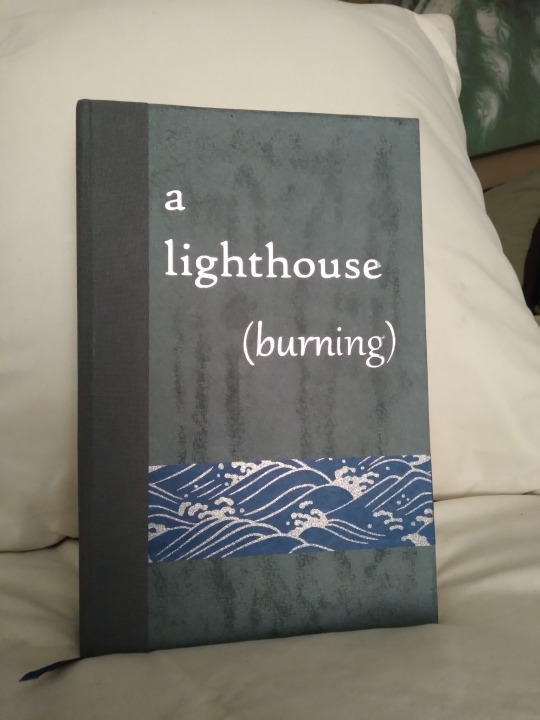
Today I've got binderary book #3 to share! It's a lighthouse (burning) by books-and-omens. This is a really excellent canonverse (sort of) historical setting liminal ghost story-esque fic that I read practically in one sitting sometime last summer. It's fantastic, well-characterized, angsty and fluffy and fairly plotty and with some really unique worldbuilding. I honestly can't sing its praises enough; it's one of the only times since taking up this hobby that I've known I wanted to bind something before I actually finished reading it.
Have a look at the rest of the photos under the cut; this one came out really well and I'm in love with it.

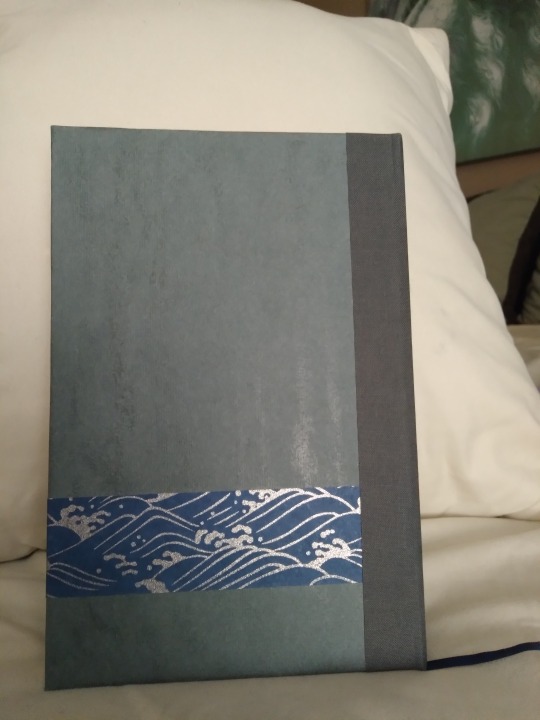
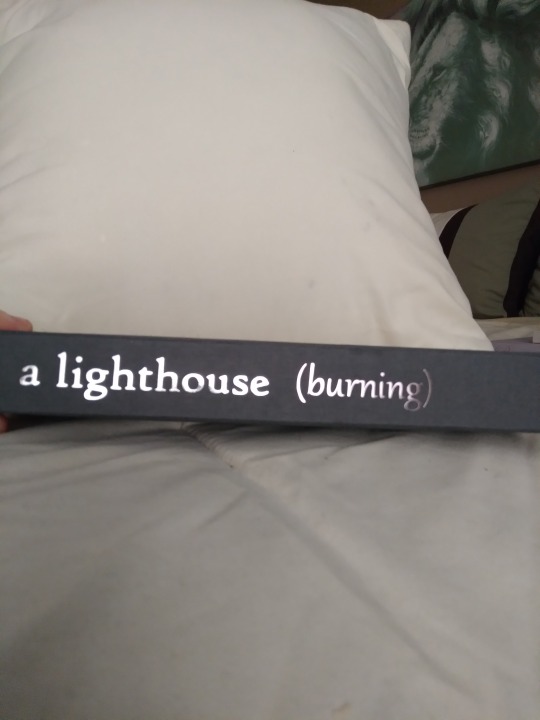
For this cover we have lineco book cloth on the spine, a strip of chiyogami paper that I got in one one ChibiJay's random paper packs, and blue-gray sketch paper for the primary gray space. It's a little hard to tell in the photos but the HTV for the titles is in two different colors, silver for "a lighthouse" and pewter for "(burning)". The effect is more pronounced in person and I love it. The pewter came in a multi-pack of cricut foil HTV and I can't seem to find it on its own anywhere, which is a shame because it's beautiful. The sort of streaky effect on the cover was unintentional but I'm kinda liking it? It's a more porous paper for drawing or painting or something, and I tried to wax it for waterproofing, but when I used the heat press to get the title on the wax darkened in the spots where the glue was applied to the cover board. At first I was disappointed, but the fic features a really massive unnatural storm, and it sort of looks like water running down a windowpane, so I'm leaning into that and calling it an aesthetic. The back didn't get this heat treatment, so it doesn't have the pattern.

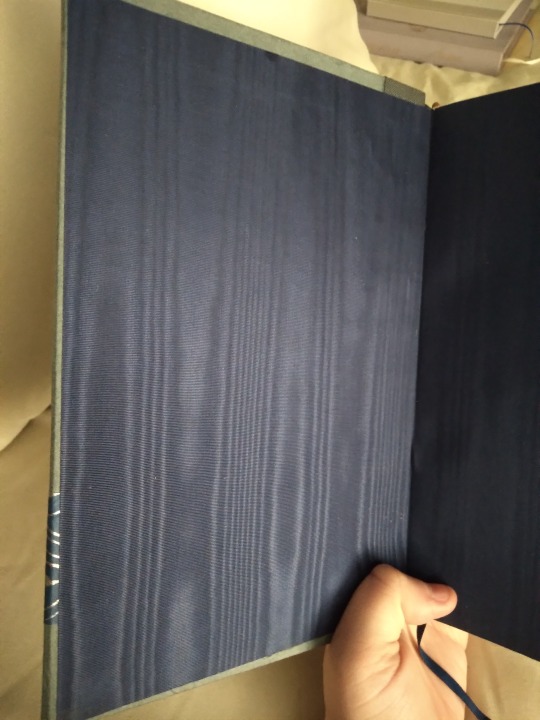


Top view, showing the bookmark and handmade end bands. The bookmark is a navy blue ribbon cut from the inside of a shirt, and I chose red and white because there are so many picturesque lighthouses that have red and white stripes. It's the only color in the book that's not blue or gray. The endpapers are a navy blue silk moire, and I had better luck with them than I did with the platinum ones on my Persuasion bind even though they are the same brand. Maybe it's practice or maybe navy just hides more sins than platinum.
For the title page I went fairly simple (for me anyway) with just a frame I pulled from rawpixel. It suits the story, though, being set sometime around or before the early 20th century. I also played with text colors on the title page, with some words being grayed out to mimic the effect on the cover. The section break is me getting clever with a feature of my printer. I often use a gray line to denote section breaks, but for whatever reason my printer doesn't like them and often makes them blurry. It is only these lines that come out blurry; larger images don't do this even if they are complex. So for this one, where a major feature of the story is trying to figure out what's real and what's a supernatural occurrence, I made one that was deliberately heavier in the center so it would come out sort of smoky or fuzzy, like it wasn't quite real and couldn't be clearly seen. It doesn't look this fuzzy in the unprinted file but I love the effect and I feel very clever for manipulating the printer like this.
I'm going to show off some interior shots but this bit contains spoilers for the story, so if you don't want to see that then maybe skip the rest of the post.
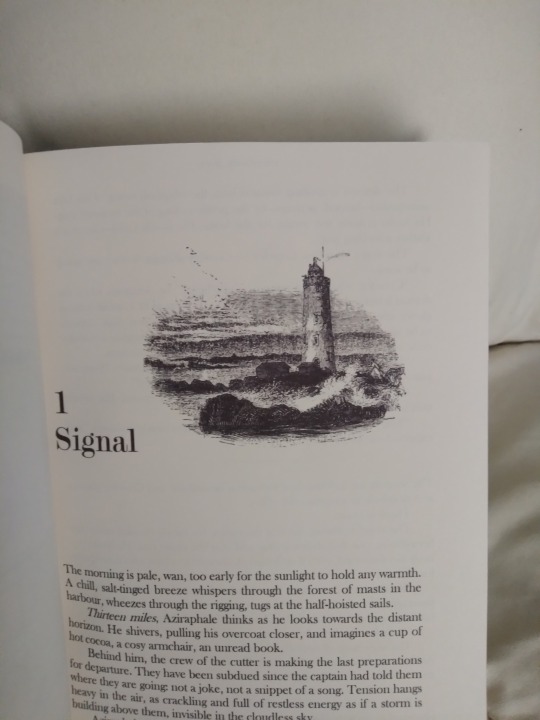


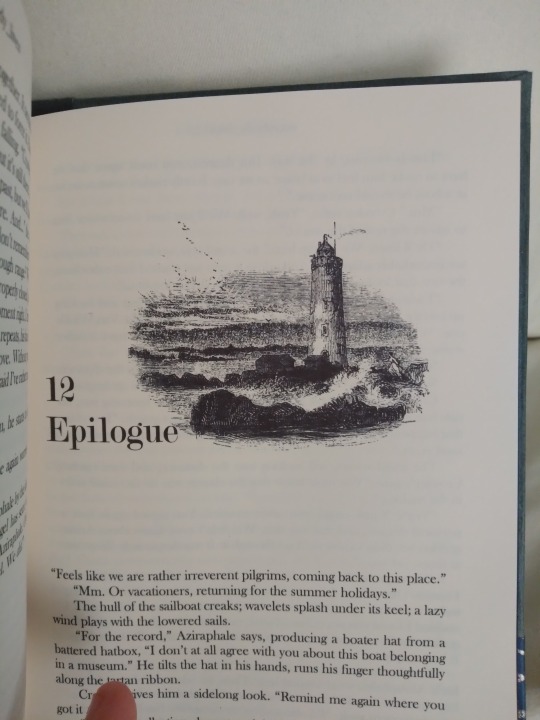
I wanted to get creative with my title placement since a lot of my binds look very similar inside, and this concept really let me try that out. The plot of the story is that the reason there are so many supernatural phenomena at this lighthouse is that someone in the future ran an experiment to harvest energy and accidentally cracked spacetime with it, and bits of the future and the past and the might-have-been are seeping through the cracks, and the longer the cracks exist the more seeps through them and the worse the ghostly stuff gets. At first it's not clear whether there's anything weird happening at all, and it becomes clearer that something is wrong the further in you get because the cracks are worse. So I had this idea for a vintage lighthouse illustration with an overlay of cracks in glass, that become more defined as the story progresses until something is done and they're sealed up in the end. I am not a visual artist and even this straightforward concept was too much for my skills, so I chose the lighthouse and the crack overlay and my amazing husband did the actual image manipulation. There are five different images, with the cracks invisible in the first and final chapter and most visible in chapter 10 and 11, when the characters are trying hardest to fix the problem. I'm really really proud of how well this turned out.
And that's it! I have several more binderary books to post but they are all still waiting for titles before I do the photos, so I don't know when I'll have them up.
#guys i love this book it came out so pretty#though it was a struggle at times#it got trimmed crooked and the gilding had to be scrapped and then the case was too small#so it actually got trimmed like 4 times#totally worth it though i mean look at it#everyone look at the cool thing i made#i'm so proud of it!!#bookbinding#fanbinding#snek makes books#good omens#fic rec
128 notes
·
View notes
Text
mario movie is quirky and all but it doesn't change the fact that it's just another formulaic 70 tropes in a trenchcoat type movie with a bunch of big names attached (and also a huge franchise!) that can easily generate box office success that's just going to inspire more suits to try and replicate it with other franchises what the hell is a live action minecraft movie 2025?????? sorry mario movie is goofy and good its 48% but its not soulless even if the plot kind of is i swear to god i was counting how many generic ass shots and moments it had it really follows the hero's journey structure to a T it's SO safe and its enormous nostalgia bait it's hard to be mad at it but it just has me concerned over everything being made based on a gimmick these days like the This movie the That novel. Backrooms movie? The whole horror of it was the mystique and ambiguity of just Ohhh you can no clip out of reality into this spooky liminal office and it's utterly incomprehensible and you are just helpless to a reality that you were never meant to experience. There is no mystique if there's gotta be plot and characters about it! why would it be scary any more if its like Ooh government quantum spacetime portal experiment GONE WRONG !!!! it's like how minecraft storymode fucking sucks cus its not meant to have a story and characters and you could not pay me to give a shit because the main character is literally the setting and background itself ! i am sick and tired of stuff being made based on a gimmick it never works out well!!! it's like those tiktok novels that are based on like a fanfic tag It doesnt work without preestablished characters IDGAF !!!!!! tired of going to the cinema only to be sensory overloaded and at the same time consume a nothing burger for 1hr30mins and come out feeling hollow like That's it that was like a bunch of tropes strung together ! sorry i kinda forgot where this was going im just tired of hearing news about how THIS FAMOUS INTERNET THING NOW GETS A MOVIE! and its like did we not learn from the mistakes of our forefathers.... unless you're going in with a super inspired vision and an actual story to tell its not going to end well!!! (and it never does cus its always some bozo trying to cash in on the hype instead of someone who genuinely cares and understands the source material) Idunno it's also kind of like the marvelization of movies too where everything is super Safe and Must Have a bunch of corny jokes that makes it really hard to actually care about the stakes and characters. Marvelization and MCUifcation happening a lot lately actually the damage mcu has done to cinema oh my god. Anyways i forgot where this was going but mario movie is a 4/10 What kind of movie has I'm holding out for a hero, Take on me and Mr Blue Sky all in the same soundtrack????
#siu talks#rambling rambling rambling#in regards to the tropes thing i read like a little bit of red white and royal blue a tthe book store and i just threw up in my mouth#what kind of white girl yaoi is this...?
24 notes
·
View notes
Text
Spira Classified Dossier: Lodestar Town / Anodyne Amusement Park
WARNING. AUTHORIZATION REQUIRED. SCANNING OF TRAINER ID REQUIRED.
...
.....
.......
.........
AUTHORIZATION CLEARED.
WELCOME, CHAMPION OF SPIRA.
An abandoned town that used to have been populated by people. Located in Cryptid Isle, Lodestar Town used to be one of Spira's known tourist hubs, partly due to Anodyne Amusement Park established there. It also used to be a place where one can spend their vacation in too, what with the clear, starry sky at night, as well as the white sand on the beach.
An ancient lighthouse, that once was still actively maintained, called Lodestar Tower, used to be a tourist attraction due to the fact that it was a well-maintained, well preserved relic of the past amidst being surrounded by modernization.
The residents in the place used to be very accommodating and hospitable, with several souvenir shops set up strategically in a way that people who come and go would end up seeing their wares, and end up buying them with a bit of sales talk from the owners of the shops. Everything used to be swell for Lodestar Town, until the upsurge of anomalous events ten years ago.

Nowadays, Lodestar Town is but a shadow of its former self. Everything it once had. The joys, the accommodating, hospitable people, the souvenir shops, all of those have been long since abandoned during the upsurge of anomalous events. See, residents of Lodestar Town are used to such phenomena. Hell, it is in the name of their Isle that already suggests weirdness in the place. However this time, it became too much to bear, even for them. Even during the ancient times when the Ancient Fear used to have plagued Ancient Spirans', only now did those people who were descendants of those same people from many years ago decided to abandon the place.
Some left for the mainland. Others left Spira entirely. While several weren't so lucky.

"Anodyne Amusement Park! The panacea for all your earthly problems! Bring your lover, bring your mother! Bring your entire family! Experience happiness unlike any other! The Golden Hour of Joy awaits!"
-Old Anodyne Amusement Park commercial
Anodyne Amusement Park. Whimsy Land, as some other folk of Spira used to affectionally call it. It used to be a place flooded with people, locals or tourists alike, due to the magnificence of the place altogether. The heart that keeps Lodestar Town beating, as its locals used to say. What used to be a place full of joy, laughter, hustle and bustle is now a place of eerie, deafening silence. As it is the place that took the most significant hit in terms of anomalous activity, the air of wrongness is powerful here. As if the feeling of being constantly watched looms all over the place.
Anomalous Activity
Various anomalous activity has been noted in Lodestar Town. Below are the list of the common catalogued ones.
Spacetime distortions
Synesthetic Hallucinations
Regular appearances of, vibrant otherworldly colors
Hands
Apparitions of children
Voices from unknown sources
Voices from within one's head
'People'
The texture of Lodestar Town occasionally 'graying out'
While quantifiable, such anomalous activity are considered as benign at best, yet extreme caution is needed, as the effect of said anomalous activities depend on the mentality of those who witness.
As for Anodyne Amusement park, the list of common catalogued anomalous activity are as follows.
Spacetime distortions
Synesthetic Hallucinations
Certain facilities and buildings within the amusement park contain liminal spaces
The same graying out observed in Lodestar Town
'Children'
'People'
Appearance of one's loved ones, often dead loved ones
The bodies in the water
The sky taking a cosmic texture
The inability to leave one place, no matter the path taken
'Eyes'
Electromagnetic interference
Alterations to reality
The feeling of being watched
The feeling of hotness/coldness, regardless of the current climate
The nigh-unrecognizable mesh of fantasy and reality
Noxious odorless gases that aggravate certain hallucinations
'Living memories'
Presence of --
Rain of unknown substance, theorized to evaporate into the odorless gas aforementioned above
Anodyne Amusement Park Assessment: Extremely dangerous. Hypnotic amnestic recommended as to ensure one's mentality remains intact after exploring the place for investigatory purposes. It is also advised to not stay any longer than 20 minutes within the area.
Status: It is under conjecture that Cryptid Isle's anomalous phenomenon would continue to grow until the source has been found and resolved. Site dubbed as the 'Anomalous Crater' by former Lodestar Town residents has been seen as the primary cause. However, due to ten years of neglect, the overgrowth from Cryptid Isle's fauna had obscured the whereabouts of said crater. Further investigation required.
Pokémon
Surprisingly, albeit supposed to be expected, the Pokemon left behind had adapted to the anomalous effects. Specific species, such as the Spiran Hypnos found in Anodyne Amusement Park display far more improved psychic abilities. Spiran Honedges found in this place are also displayed to be more tougher and more resilient, albeit tend to be more aggressive.
The local, singular Mr. Mime, has been observed to ████████████.
Conclusion
Due to the growing concern on Cryptid Isle, naval and aerial surveillance are to be on a 24/7 interval. Intruders are to be met with force on sight.
Only the Professor, the Eighth Gym Leader, Elite Four and Champion are authorized to explore and investigate the place.
Hypnotic amnestics from powerful psychic Pokémon are to be required after each trip, should Lodestar Town or Anodyne Amusment Park start affecting the individual's mentality at a concerning degree. Information on Anodyne Amusement Park's current status are not to be leaked out to the public.
2 notes
·
View notes
Text
According to a CIA document declassified on 08/07/2000 titled “Coordinate Remote Viewing (CRV) Technology 1981–1983,” submitted to the organization August 4 of 1983, coordinate remote viewing “utilized through the methodologies that have been developed…works with remarkable precision,” but the individuals who submitted it admitted that they were “unable to explain in conventional terms why it is that the co-ordinate serves as a stimulus in the manner it does.” Nevertheless, they were convinced that David Bohm’s model of quantum mechanics provided a potentially plausible explanatory hypothesis for the mechanisms that make it possible.
David Bohm was a controversial yet brilliant luminary in physics who argued that the entirety of the cosmos is populated with quantum black holes that lead from the “explicate order” of spacetime to a realm that transcends space and time which he referred to as the “implicate order.” These black holes were termed “holospheres,” and hypothesized as the mechanism which connects the implicate order to the explicate order. From the perspective of the remote viewer, it is possible that the signal line we acquire is mediated by these holospheres, which connects us with an implicate order that is conceptually more or less identical to the Eastern concept of “Akasha” or the “Akashic records,” as articulated in the work of writers such as Swami Vivekananda. The explicate order in which we ordinarily live and move and have our being is “unfolded” from this implicate order and houses the world of ordinary objects and consciousness, which includes what remote viewers known as the liminal, subliminal and subconscious orders.
Bohm’s “implicate order,” he hypothesized, contained sub-quantum variables that were responsible for the alleged “hidden variables” that made quantum phenomena so unpredictable. In this respect, he was not merely engaging in quantum mechanics, but sub-quantum mechanics, which he believed contained the key to understanding how the universe unfolded from a kind of Universal Mind that pervades the entire cosmos at all times. According to this model, data is unfolded from the non-spatiotemporal implicate order, which forms within the explicate order, at which point the explicate order then once again communicates with the implicate order in a way that impacts subsequent unfoldings within the explicate order from the implicate order.
Bohm used the term “implicate order” because of the etymological roots of the word “implicate,” meaning “to fold inward.” Indeed, the implicate order is “implicit” in that it underlies all of reality. Everything in the universe, for Bohm, is enfolded into everything else; a position which informs his highly relational and holistic worldview according to which all vectors necessarily impact all other vectors. This view, of course, is quite contrary to the more atomistic physics that preceded the quantum model within the Western world.
The reason the CIA was (and likely, still is!) so interested in Bohm’s physics is because of its crucial ramifications for subjectivity. Bohm was an idealist, like many of the most important founders of quantum mechanics, which means he believed that consciousness was primary. Rather than emerging from a fundamentally physical, inert, mechanistic world, according to Bohm, there is a kind of Universal Mind that precedes the physical world and generates it from its storehouse of meaning. On an individual level, a thought is enfolded into your consciousness, which then unfolds a certain thought, which then folds back, and so on, in a kind of reciprocal dynamic that mirrors the fundamental nature of the cosmos itself. Bohm labeled the cosmic embodiment of this principle the “holomovement”, which he saw rooted in the implicate order. Furthermore, he saw these thoughts as enfolded into the totality of the implicate order itself rather than restricted to individual, atomistic selves.
11 notes
·
View notes
Note
💐 once you receive this lovely bouquet of flowers you have to mention five things you love, publicly, and send it to 10 of your favorite followers if you want. SPREAD POSITIVITY! ⛅️
This is so lovely!!! 💕💕 Ok, here goes:
Sunsets—liminal spacetime! Colors unmade by man! Wonder and glory and beauty!
Tea—If I don’t have at least two cups a day, I will perish
My cat—I need to show her on here sometime; she’s my angel baby
Books—basic, but I mean
Well-written characters with thoroughly developed arcs, vivid voices, and thoughtful storylines (bonus points if played by attractive people) 😊
2 notes
·
View notes
Text
poem #11
this one is from apr 16, 2019
this has been my one and only attempt at writing a sonnet so far, but maybe i'll try again now that i'm more practiced. the restrictions are both a challenge and a hindrance...
if i remember correctly, i wrote this on a scrap of paper while on a road trip.
liminal positions in spacetime, like long car rides, inspire thinking (and overthinking) because you become your own captive audience.
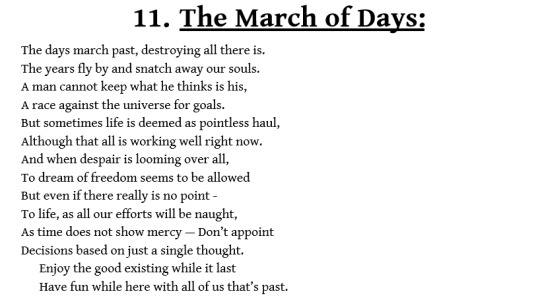
#poetry#poem#writing#early work#old work#sonnet#passage of time#time#creative writing#writeblr#poets on tumblr
2 notes
·
View notes
Text
Astral Diary: 20230916-UN-DB (16/9/23 - unknown location - recorded by me in my body)
Woke up, I wasn't dreaming about anything though Lev was in my dreams - or more so influencing them, which may be because I was around him and his energy. Either way, I had the distant but sustained thought when I woke up that I needed to record last night, despite the fact that I didn't actively remember that I'd been anywhere. Obviously in the astral I sat there telling myself I needed to remember this.
I'm trying to remember, I see I'm standing in what seems to be a tall room reminding me of those sorts of personal libraries with bookshelves, possibly firelit (it's some sort of darkness and some sort of orange light), listening to Ahi and Lev talking about something. The language they're speaking is ancient and heavy, not in the way that it's say guttural or forceful but literally heavy, seeped into the air around them and weighing it down like inhumanly thick steel rods used for skyscraping architecture. The language is taut, it's... I keep coming back to the word heavy. It throws shadows across reality like an ocean throws waves, it's warping things subtly not in the liminal way but like the shift in spacetime caused by the mass of an object, gravity. It's a very 'truthful' language, but even I'm not sure what I mean by that beyond the fact that I know it's not accurate to compare it to the usual reality warping that happens when Ahi and indeed Leviathan is present, a warping that is subjective and caused by the penetration of will into matter... Instead this is similar, the same context even of that penetration, but it's so present.
2 notes
·
View notes
Text

headcanon; Wait, wait. One more. So, because Ransei was, at one point, the “doorway” between earth and the Hall of Origin, literally part of the heavens itself, Ransei is... kind of a liminal space. Physically speaking, yes, Ransei exists as a fixed point in space and can be located on a map and so on and so forth. However, in spite of this, Ransei, at least until very recently, is traditionally extremely difficult to reach.
In addition: theoretically, any pokemon could appear in Ransei because of this liminality. That’s kind of how Zekrom turned up in Ransei despite the fact that there is no logical way Zekrom should’ve been able to show up in Ransei. Some of the special locations that appear in Ransei (such as those where legendaries appear) are comparable to spacetime distortions in Legends: Arceus or Ultra Wormholes. Space just gets fucky-wucky in Ransei in a way that the people who live there are just, like, kind of used to. This has been going on for literal centuries. DW about it.
7 notes
·
View notes
Text
hm not to be like, chuck won and designed the ending, But just saying uh like. Cas always dying literally within arm's reach just through a crack or a gap or a portal is very interesting to me. firstly just the fact that there is always this liminal space involved, a passage that should not exist, links between universes we know are not designed to interact and Yet. every time, man. always a portal, always a tipping point in the overarching arc. God turning the page to finish the chapter and each time he tries to tie Cas up like a loose end.
Cas always dying close enough to touch, dean grasping for him in purgatory and so vividly meaning to pull Cas away that he literally rewrites the events in his subconscious, Cas finally making it through the tear in spacetime from apocalypse world-- just for an arm to reach literally across the multiverse to kill him, and of course uh. the other one. Despair. where Cas is not only within arm's reach, but everything dean couldn't have, everything he never let himself want, is within arm's reach: a world where he is good, a world where he is loved, a world where it is enough to love, a life WITH Cas instead of just a life with Cas in it.
And his punishment is a world without Cas in it at all. A big fuck you to cas as always, but this time it's really directed so scathingly at Dean's entire core as a character. sometime to never recover from, he really like just loses hope for good. again, Cas is plucked away by the invisible puppet strings god and the writers have on all of them.
and maybe each time Cas could have lived if chuck wasn't jerking strings. and chuck hated Cas so much toward the end, for the same reason Naomi and Michael all hated Cas, because he was unbound from the inner mechanisms of the universe, untethered from divine fate and punishment and cyclical narrative like the rest of them. so I like to think he gets so close each time because chuck can't stop *him*, so it always has to be Dean's failure to catch Cas, it always has to be some in invisible hand around Dean's throat that has existed since before his birth, grinding him into paste, keeping him beautiful and always in tears because it looks good in screen and we love to see him bloody he looks so good when he's losing-- choking him a second too long whenever it really counts. because if Dean ever got what he wanted, there would be no story.
so anyways
11 notes
·
View notes
Text
exam session is a liminal spacetime object.
days are arbitrary, the clock necessary only as much as to know when u gotta be where. thoughts vacillate between homicidal urges towards anything that ticks you off & wanting to be held lovingly in a parental figure's arms.
#if i make it through the week it will already be a big win#i pray for strength and motivation and attention span 🙏#šī sesija reāli tā iesūkā man besī besī besī universitāte pls pis nahuj mani nervi ir Beigti#text
12 notes
·
View notes
Text
Okay, but I wanna talk about Naomi's Library, because it's a character unto itself and I love it.
Lullaby Lane Library is semi-sentient. Actually, the Lane itself is semi-sentient, it's just that the Library is where it concentrates itself the best - it's the "face" of the entire thing.
The whole lane and everything on it is contained in a loosely-defined pocket dimension - "Built on a dream", as Naomi puts it - and is one of those places where the road can lead anywhere, but generally just loops back on itself when it's not pulling anyone in. Rather than being in a bubble, it manifests connections when they're needed and lets go when they're not.
(This means its appearance on maps is variable and inconsistent. Naomi's given up giving directions and started saying "Just go to a park and walk down the nature trail, you'll get there if you think about it.")
If forced to put a name to itself, the Lane could be described as a Genius Loci, eldritch and unknowable, something between liminal and alternate dimension. It is not of human making or understanding...
But it loves, deeply and wholly.
Not even in a monstrous way! The place operates a lot like other magical places in kid's media, growing brighter and more colorful as it's loved and cared for, adding new and bright and colorful things to fill its space. It reaches out to new places to give its inhabitants new worlds to explore, because it wants its people to have full, rich lives.
It loves Naomi!!! Naomi loves her library!!! It's cosmic comfort rather than cosmic horror. I love that weird road that doesn't have a fixed location in spacetime, with an old-timey library across from the dried-up brook.
1 note
·
View note
Text
Your Son (october 8th, 2023)
you burn fast
to disappear in an instant.
what does it feel like
forgotten?
to have a desire and a
fire, quelled..
suffocated?
what does it sound like
being tossed into the vortex?
the spacetime, bending, breaking,
but still whole? still just you?
an anomaly? only just for your life.
this life. stars
staring, too old to have lived now,
too far to be seen now.
what does it taste like
to be dribbled in chocolate
cream, a butter, a lather?
what does it look like
to discharge violet energy
at anyone who is pulled in, walking by?
money, shine,
power. shadows,
sticks, firelight.
the vacuum of your touch. to
exist in that liminality, at the same
time as that, to behold, to brush against —
to hold. i bring down stars,
too hot, to memorize. i cry
in crests for fallen angels.
0 notes
Photo


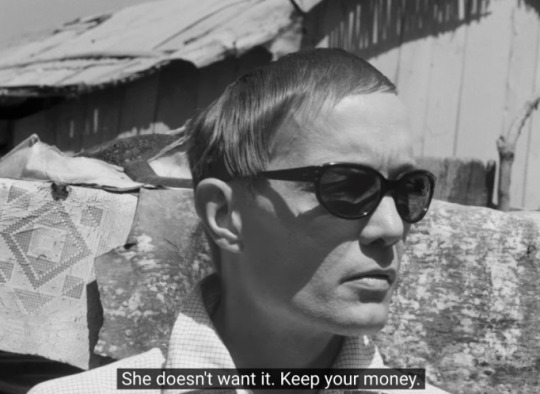

Riding The Waves Towards Elsewhere: Cinematic Memory and African Cosmology in Ousmane Sembène’s “La Noire De,” 1966
By Christie Neptune
Ousmane Sembène forges a temporal shift of immanent-transcendence in “La Noire De '' that pushes the viewer beyond a linear progression of time towards an Elsewhere [1]. What is Elsewhere and how might one get there? Although the nature of such is not clearly defined, Sembène utilizes totemic tropes of water [2], cinematic memory and non-diegetic space to frame its milieu. One’s understanding of Elsewhere is acquired through the subjective experience of Diouana, the film’s protagonist, and the time bending notion of Now [3]. Diouanna’s Now is grounded in an African cosmology of spacetime. It exists within a perpetual state of becoming and traverses the past, present and future. It is our understanding of Diouana’s Now that moves us towards an Elsewhere, ethereal space unbound by the camera’s frame.
It is rather poetic when you think of it. The notion of Elsewhere holds a sharpness that is piercing and to the point. Although we know not where that point is, we ride the waves [4] nonetheless, moving along its ebb and flow towards the unknown. Waves persist. Becomes. And, flow like the crushing force of Now yonder into a realm fixed within a concentric progression of time that has neither beginning nor end.
In “La Noire De” Waves operates as an ‘in between,” a powerful force that moves Diouana between worlds, geopolitical spaces and conscious states. We witness the devolution of Diouana in her migration across the Atlantic, from one geopolitical space to the next [5]. The Atlantic, in this segment, functions as a border between states: “Diouana” and “The black girl.” Cinematic memory [6] posits an entry into the liminality of this domain and utilizes a technology of recollection to explain Diouana’s present. We understand that she is oppressed through the framed juxtapositioning of past experiences and present resentments. Her past brings to fore the varied dimensions of her humanness. It paints vividly, her desires, fears, and aspirations. On film we see that Diouana’s Now is tinged by racial dominance and a conscious awareness of it. In her movement backwards, she becomes disillusioned [7] and develops an acute awareness of self in her trajectory forward.
The notion of Now compels action in this film. Diouana’s journey towards Elsewhere begins as a conscious intervention. She resists. She refuses payment from her hosts. She packs her bag. She braids her hair. She fills the tub with water. She submerges herself in it and transitions. The scene ends with a matching frame of a Frenchman at the beach reading a news article covering her passing. The Atlantic ebbs and flows amid blithely unconcerned beachgoers, the lives of her oppressors resume as normal and Diouana, our film’s protagonist, charges forward riding the waves towards Elsewhere. As water is an ‘in between,’ a regenerative force that moves us across the varied dimensions of time towards borders, the viewer understands that there is no permanence to Diouana’s end. The film suggests, rather, the existence of a third space, space beyond the camera’s frame and the viewer’s corporeal understanding, for the film cannot persist in the absence of its protagonist. Sembène’s use of non-diegetic commentary, affect and mirrored action structures that which is signified, Elsewhere.
In film theory, the spectator is a signifier within a system of signifiers that communicates meaning within film discourse. In “La Noire De” Diouana’s inner dialogue, actions and the viewer’s understanding of its implications works to establish meaning and countenance of Elsewhere.
I did not come here for the apron or the money.
Never will she see me again.
Never will she scold me again.
Never again, Diouana.
Never will I see them again.
The mistress lied.
She always lied.
She’ll not lie to me again.
Never will she lie to me again.
She wanted to keep me here as her slave. (Sembène 1966)
Voiceover narration oscillates within structured space beyond the scene. Unlike diegetic sound, Diouana’s provocations are unheard by her French oppressors. One can only imagine the narrative that would unfold if ever a black woman’s silenced rage were heard in contest to racial dominance. Although I would appreciate a visceral monument of unchecked feminist black rage in cinema (i.e Pam Grier’s “I want you to suffer” scene in Foxy Brown or Angela Basset’s “Revenge” scene in Waiting to Exhale to name a few), I find Sembène’s grounded act of resistance and evocation of Elsewhere palatable.
To “pack,” “package” or “prepare” signifies flight [8]. As intransitive verbs they suggest departure, a “movement from” and “travel to.” Before the revelation of subsequent scenes within the film’s chronological structure, the viewer has a clear understanding that Diouana is taking off. Non-diegetic space fosters as a site of resistance. Not only is it beyond the camera’s frame but more importantly, it is unreachable to her oppressors. It is what Fred Moten, critical theory and black studies professor, defined as the ‘flight from the enclosed.’ Elsewhere as fugitive space? Elsewhere as black representational space? Elsewhere as another dimension within the continuum of spacetime? Although the nature of Elsewhere is implied but never clearly defined, I would like to consider, for the sake of this essay, the potential of Elsewhere as an added dimension within the continuum of spacetime, beyond our corporeal understanding. Within this framework, Diouana’s Elsewhere is grounded within an African cosmology that advances the notion of black femina ira edcatus [9]. I introduced this phrase to mean the rearing of unchecked feminist black rage across the continuum of spacetime. The word stems from the Latin root “femina” for “woman,” “ira” for “rage” and “educatus” for “rear” or “bring up.” As time persists, so must the protagonist’s anger within the continuum of time. This notion is seeded within an African world-making framework that counters western articulations of temporality.
It suggests, rather, that time is concentric, the superimposition of the past, present and future upon one axis. The past moves with us and the future is shaped by the actions and conscious underpinnings of the present. It is our Now. I’ve explored this notion earlier within this paper. However, at this stage, I would like to stress this perspective of time as a mode of departure. In 2013, the curators of the University of Michigan Art Museum organized a show entitled “African Art and the Shape of Time [10].” The exhibit featured the works of about two dozen (or more) artists and explored the material productions of African temporality by African Artists over the span of three centuries.
What was central to the exhibit, well for me upon close examination, was the cyclical portrayal of time embodied within most works. For example, Kunda (late 19th century), a double bell made by the Kongo peoples of Central Africa, depicts time as a cyclical progression. The Kongo people's belief system, explaining such, are carved onto the surface of a wooden double bell, an apparatus of necessity for spiritual conjurings and ceremonies that converges cosmic states (again, the past, present and future).
In Kongo though, ancestors are understood to exist “elsewhere in time,” but they can be called upon to cross into the present–to move through time. Once the bell is set in motion with a flick of the wrist it produces a dense muffled ratte, signaling the opening of a new temporal plane on which the past momentarily inhibits the present imparting to the living the wisdom to shape the future with greater clarity (Mier, Silverman and Gurstelle).
Although I find this notion rather intriguing, I would like to argue that it is not the past which imparts “wisdom to shape the future.” The past is an embodiment of Now which persists. Becomes. If time within an African perspective is the superimposition of multiple temporal planes upon one axis then Elsewhere is an added dimension beyond our corporeal three dimensional (3D) understanding, one that also persists within the continuum. I imagine an Elsewhere beyond an Elsewhere; a persistence of affect where added dimension (one moving beyond 3D) grants one the affordance of varied entry points within spacetime. Is it possible that the Kunda Bell simply functions as a token of acknowledgement, one that acknowledges the affective fields of future states imparted upon the present by an advanced dimension in ceremony?
The Kongo peoples embodiment of time suggests the existence of Elsewhere, a temporal plane parallel to our world for the ancestors. The Kunda Bell emits a sound that posits a bridge between both worlds, this I understand. However, I feel that the nature, the ontology of the continuum is more nuanced and tangled than a bidirectional flow of entities moving from one world to the next. It implies that the progression of time comes to a halt in the afterlife. This notion defies the very nature of physics. Although the sound wave emitted from the Kunda Bell fades over time, the movement of atoms and molecules still persists and sound is transformed further into energy. Such is the nature of all things. For this reason, (this of course is without doubt speculative) I believe that Elsewhere also exists within the continuum, a composite of multiple planes without beginning or end.
The shadow of my existence will cast a two dimensional figure upon any surface. I can only imagine what an added dimension beyond the corporeal realm of my 3D would look like as a casted shadow in space. Although it is beyond my perceptual reality, the existence of Elsewhere is signified through my understanding of both African and Western cosmologies. Understanding, in this case, functions as a heightened sensitivity. It is the reckoning of affect, the casted shadow of an advanced dimension in space. In “La Noire De” this reckoning is channeled in the defiant acts of resistance articulated by Diouana’s mother and brother.
Following Diouana’s transition, her French oppressor returns her belongings to Senegal and offers to pay her mother. However Diouana’s mother refuses payment in the same manner that Diouana refused salary. Both scenes are marked by a non-compliance to racialized subjugation and a spirited rejection of the Frenchman’s gaze. In the subsequent scene the Frenchman is greeted by the masked younger brother of Diouana. The young boy haunts him. He places the tribal mask returned by the Frenchman upon his face and chases the Frenchman to the village’s border. Both actions, the mother's rejection of payment and the brother’s haunt resist. They are what I consider the film’s black femina ira edcatus, the rearing of Diouana’s rage across the continuum of spacetime, or rather the casted shadow of her advanced dimension articulated in space by her mother and brother.
At this point “the myth of colonial assimilation” is wholly disavowed. The scenes beginning with Diouana’s resistance are charged with symbolic tropes of anticolonialism and decolonial epistemologies. Sembène’s use of non-diegetic space, totemic tropes of water and cinematic memory in “La Noire De'' proffers a glimpse into Elsewhere. In Diouana’s flight from the enclosed, she rides the waves towards an alternate temporal plane forged by resistance. The waves towards Elsewhere within the African Diasporic context varies, of course. Is it ocean waves (i.e. water)? Is it light waves? Is it sound waves? Is it a composite of all three (or more)?
In Central Africa, the ancestors of the Kongo people ride the vibrating waves of sound from their world into ours. In African folklore the water spirit, Mami Wata [11] uses the ocean to transport beings of our realm into the spiritual world. And, in Dahomey Mythology, the goddess of light, Mawu-lisa [12] is a life-source and creator of all things within the continuum of time. Can the ethos of anticolonialism embodied in the denouement of “La Noire De” be interpreted as a flight from western world making universals towards an African cosmology and perspective? Well, what do you think?
Notes:
In African cosmology “elsewhere” is another temporal plane beyond the living. See, Mier, Silverman and Gurstell “African Art and Shape of Time.” In African Arts, Spring 2013, Vol. 46, No. 1. See also, Wyatt MacGaffey (2007:207).
In “Liquid Africa,” Ekow Eshun describes water as the source of creative regeneration, mediator of stories and border to new states of being. See, “Liquid Africa” in Liquid Blackness: Journal of Aesthetics and Black Studies, Duke University Press, 2021, pgs 74-87.
The notion of “now” explores Michelle M. Wright’s theoretical framework of Epiphenomenal time. “In physics of blackness. “...Epiphenomenal time is a lens in which the past, present and future is articulated. See, Physics of Blackness: Beyond the Middle Passage Epistemology, University of Minnesota Press, 2015, pg 1-35.
A metaphor that builds upon notions of African temporality commonly employed in art, folklore, mythology and films of the African diaspora.
In “La Noire De” Diouana is hired as a permanent nanny by French Colonizers and moves across the Atlantic from Dakar, Senegal to Antibes, France for work.
The notion of “cinema memory as a “cultural experience” that illuminates the intimate and “micro” process through which subjectivity binds itself with culture, place and nation…” (Radstone 338). See, Susanah Radstone. “Cinema and Memory.” In Memory: Histories, Theories, Debates,
Sembène reveals in both the short story and film adaptation of “La Noire De” the “deleterious myth of colonial assimilation, tracing Diouana’s path from enchantment with France to disillusion, which eventually leads to suicide,” (Virtue 557). See, Nancy Virtue. “‘Le Film de...’: Self-Adaptation in The Film Version of Ousmane Sembène’s ‘La Noire De ...’” Literature/Film Quarterly 42.
See Stefano Harney and Fred Moton, in The Undercommons: Fugitive Planning & Black Study. Minor Compositions, 2013.
Femina Ira educatus stems from the Latin root “femina” for “woman,” “ira” for “rage” and “educatus” for “rear” or “bring up.” I use the phrase black femina ira educatus to mean the rearing of unchecked feminist black rage across the continuum of spacetime. As time is persistent, Diouana’s anger persists and is evinced in the actions of her family members and subsequent generations.
African Art and The Shape of Time, August 18, 2012 - February 3, 2013. The Alfred Taubman Gallery II in the Maxine and Stuart Frankel and The Frankel Family wing. The University of Michigan Museum of Art, Ann Arbor, MI.
In African folklore Mami Wata is an African deity who uses a mirror and water to travel between past, present and future states. In “The Nanny” (2022), a film adaptation of Ousmane Sembène’s “La Noire De” (1966), filmmaker Nikyatu Jusu directly references the African deity, Mami Wata to converge the temporal planes of the past, present and future. The affective fields of the future haunt the protagonist's present state in the collapse of time’s linear progression. See, Jusu, Nikyatu. “The Nanny.” 2022, United States. Blumhouse Television, United States, HD.
Mawu-lisa is a deity of the sun and moon in Dahomey mythology.
Bibliography:
Wright, Michelle M. “Introduction.: Many Thousands Still Coming: Theorizing Blackness in the Postwar Moment.” In Physics of Blackness: Beyond the Middle Passage Epistemology, 1–36. University of Minnesota Press, 2015. http://www.jstor.org/stable/10.5749/j.ctt130jtph.3.
Barthelme, Donald. “Not Knowing.” Not Knowing: The Essays and Interviews of Donald Barthelme. Ed. Kim Herzinger. New York: Random House, 1997.
Eshun, Ekow. 2021 “Liquid Africa.” In Liquid Blackness: Journal of Aesthetics and Black Studies edited by Alessandra Raengo, Lauren McLeod Cramer, 74-87. North Carolina: Duke University Press.
Meier, Prita, Raymond Silverman, and Andrew Gurstelle. “African Art and the Shape of Time.” African Arts 46, no. 1 (2013): 72–81. http://www.jstor.org/stable/43306128.
Radstone, Susannah. “Cinema and Memory.” In Memory: Histories, Theories, Debates, edited by SUSANNAH RADSTONE and BILL SCHWARZ, 325–42. Fordham University Press, 2010. http://www.jstor.org/stable/j.ctt1c999bq.26.
Sembène, Ousmane. “La Noire De.” 1966, Senegal. Filmi Domirev and Les Actualités Françaises, France. 35mm.
Stefano Harney and Fred Moten, The Undercommons: Fugitive Planning & Black Study. (New York: Minor Compositions, 2013), chapters 1-3 (pp. 14-57).
Virtue, Nancy. “‘Le Film de...’: Self-Adaptation in the Film Version of Ousmane Sembène’s ‘La Noire De ...’” Literature/Film Quarterly 42, no. 3 (2014): 557–67. http://www.jstor.org/stable/43798991.
1 note
·
View note
Text
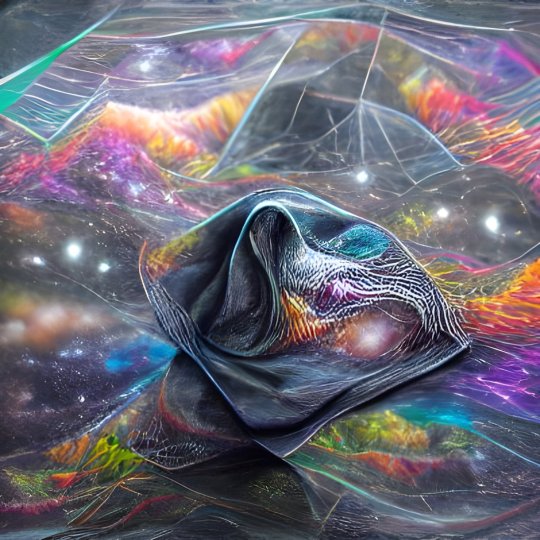
"The Liminal Spacetime Rag" - made with NightCafe Creator
1 note
·
View note